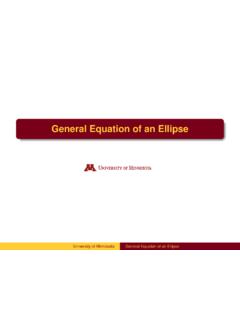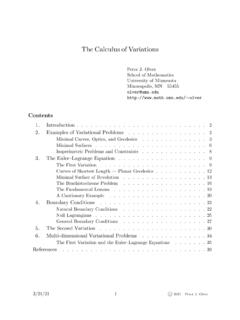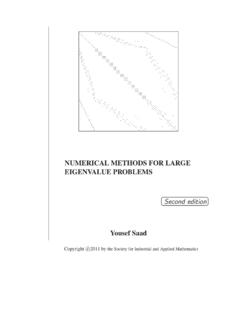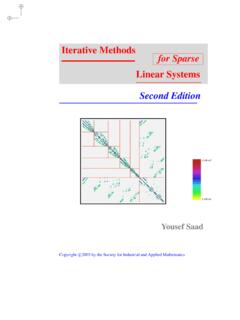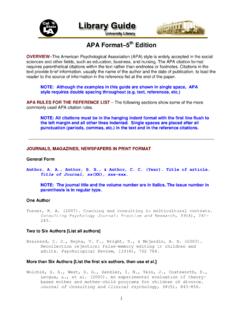Transcription of Introduction to Data Mining - University of Minnesota
1 Introduction to data MiningInstructor s Solution ManualPang-Ning TanMichael SteinbachVipin KumarCopyrightc 2006 Pearson Addison-Wesley. All rights Introduction12 Data53 Exploring Data194 Classification: Basic Concepts, Decision Trees, and ModelEvaluation255 Classification: Alternative Techniques456 Association Analysis: Basic Concepts and Algorithms717 Association Analysis: Advanced Concepts958 Cluster Analysis: Basic Concepts and Algorithms1259 Cluster Analysis: Additional Issues and Algorithms14710 Anomaly Detection157iii1 Introduction1.
2 Discuss whether or not each of the following activities is a data miningtask.(a) Dividing the customers of a company according to their This is a simple database query.(b) Dividing the customers of a company according to their This is an accounting calculation, followed by the applica-tion of a threshold. However, predicting the profitability of a newcustomer would be data Mining .(c) Computing the total sales of a Again, this is simple accounting.(d) Sorting a student database based on student identification Again, this is a simple database query.
3 (e) Predicting the outcomes of tossing a (fair) pair of Since the die is fair, this is a probability calculation. If thedie were not fair, and we needed to estimate the probabilities ofeach outcome from the data , then this is more like the problemsconsidered by data Mining . However, in this specific case, solu-tions to this problem were developed by mathematicians a longtime ago, and thus, we wouldn t consider it to be data Mining .(f) Predicting the future stock price of a company using We would attempt to create a model that can predict thecontinuous value of the stock price.
4 This is an example of the2 Chapter 1 Introductionarea of data Mining known as predictive modelling. We could useregression for this modelling, although researchers in many fieldshave developed a wide variety of techniques for predicting timeseries.(g) Monitoring the heart rate of a patient for We would build a model of the normal behavior of heartrate and raise an alarm when an unusual heart behavior would involve the area of data Mining known as anomaly de-tection. This could also be considered as a classification problemif we had examples of both normal and abnormal heart behavior.
5 (h) Monitoring seismic waves for earthquake In this case, we would build a model of different types ofseismic wave behavior associated with earthquake activities andraise an alarm when one of these different types of seismic activitywas observed. This is an example of the area of data miningknown as classification.(i) Extracting the frequencies of a sound This is signal Suppose that you are employed as a data Mining consultant for an In-ternet search engine company. Describe how data Mining can help thecompany by giving specific examples of how techniques, such as clus-tering, classification, association rule Mining , and anomaly detectioncan be following are examples of possible answers.
6 Clustering can group results with a similar theme and presentthem to the user in a more concise form, , by reporting the10 most frequent words in the cluster. Classification can assign results to pre-defined categories such as Sports, Politics, etc. Sequential association analysis can detect that that certain queriesfollow certain other queries with a high probability, allowing formore efficient caching. Anomaly detection techniques can discover unusual patterns ofuser traffic, , that one subject has suddenly become muchmore popular. Advertising strategies could be adjusted to takeadvantage of such For each of the following data sets, explain whether or not data privacyis an important issue.
7 (a) Census data collected from 1900 1950. No(b) IP addresses and visit times of Web users who visit your (c) Images from Earth-orbiting satellites. No(d) Names and addresses of people from the telephone book. No(e) Names and email addresses collected from the Web. No2 Data1. In the initial example of Chapter 2, the statistician says, Yes, fields 2 and3 are basically the same. Can you tell from the three lines of sample datathat are shown why she says that?Field 2 Field 3 7 for the values displayed. While it can be dangerous to draw con-clusions from such a small sample, the two fields seem to contain essentiallythe same Classify the following attributes as binary, discrete, or continuous.
8 Alsoclassify them as qualitative (nominal or ordinal) or quantitative (interval orratio). Some cases may have more than one interpretation, so briefly indicateyour reasoning if you think there may be some :Age in :Discrete, quantitative, ratio(a) Time in terms of AM or PM. Binary, qualitative, ordinal(b) Brightness as measured by a light meter. Continuous, quantitative,ratio(c) Brightness as measured by people s judgments. Discrete, qualitative,ordinal(d) Angles as measured in degrees between 0 and 360 . Continuous, quan-titative, ratio(e) Bronze, Silver, and Gold medals as awarded at the Olympics.
9 Discrete,qualitative, ordinal(f) Height above sea level. Continuous, quantitative, interval/ratio (de-pends on whether sea level is regarded as an arbitrary origin)(g) Number of patients in a hospital. Discrete, quantitative, ratio(h) ISBN numbers for books. (Look up the format on the Web.) Discrete,qualitative, nominal (ISBN numbers do have order information, though)6 Chapter 2 data (i) Ability to pass light in terms of the following values: opaque, translu-cent, transparent. Discrete, qualitative, ordinal(j) Military rank. Discrete, qualitative, ordinal(k) Distance from the center of campus.
10 Continuous, quantitative, inter-val/ratio (depends)(l) Density of a substance in grams per cubic centimeter. Discrete, quan-titative, ratio(m) Coat check number. (When you attend an event, you can often giveyour coat to someone who, in turn, gives you a number that you canuse to claim your coat when you leave.) Discrete, qualitative, nominal3. You are approached by the marketing director of a local company, who be-lieves that he has devised a foolproof way to measure customer explains his scheme as follows: It s so simple that I can t believe thatno one has thought of it before.
